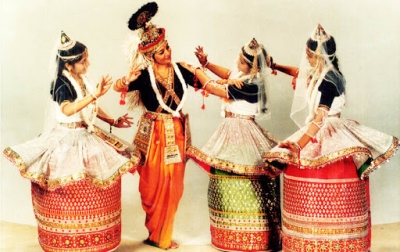
The costumes for Manipuri dancers, particularly for women are quite unique from other Indian classical dance forms. A male dancer wears a bright coloured dhoti, also referred as dhora or dhotra that covers lower part of his body from waist. The unique style of wearing it gives the dancer the flexibility to perform his footwork. A crown decorated with peacock feather adorns the dancer’s head, who portrays the character of Lord Krishna. The costume of female dancers resembles that of a Manipuri bride, referred as Potloi costumes. These costumes were introduced for dancers characterising Gopis in ‘Rasa Lila’ dance by Meidingu Bhagyachandra Maharaj. The most distinguished of these is the Kumil costume that is an exquisitely embellished long skirt in the shape of a barrel with a stiffened bottom. The skirt is embroidered with fine gold and silver works decorated with small mirror pieces and designs of lotus and other natural items as border prints. The top border of Kumil adorns a wavy and translucent fine skirt tied in three places around the waist in Trikasta and opens up like a flower. A velvet choli or blouse adorns the upper part of the body and a translucent veil white in colour covers the head. The dancer wears round shaped jewellery or garlands of flowers to adorn her face, hand, neck, waist and legs that synchronize well with her costume. However unlike other Indian classical dance forms a Manipuri dancer does not wear a ghunghroo that is a musical anklet made of leather straps with small metallic bells attached to it. The entire get up of the dancers performing gracefully onstage complimented with devotional music gives the feel of watching floating apsaras.
The drummers who also dance while drumming are male artists. They wear white dhoti that covers the lower part of body from waist and a white turban on the head. A shawl neatly folded adorns their left shoulders while the drum strap falls on their right shoulders.
Picture Credit : Google




